With every passing project I feel like my basement is being converted from a living only area, to a work and project area. Computers being built, gadgets being taken apart, Lego projects all around. I’m not complaining by any means, but I do feel as my basement becomes populated with more and more tech based projects that the environment is missing something organic, something natural to balance things out.
I’ve been interested in working on a project for while that would combine something tech-based with something organic. Mixing the two elements intrigued me for a while. I’ve wanted to add flowers, or maybe plants of some sort to blend a little bit of nature into the space. I do receive a bit of sunlight through a glass block window, but the temperature in the basement is usually on the colder side. In the winter I don’t really heat the space because the folding farm outputs enough heat to keep the temperature comfortable. I didn’t want to change that aspect so I needed to come up with something that would tolerate slightly cooler temperatures and limited sunlight.
I can’t exactly recall when the idea came to me, but at some point I started wanting to use the heat from a computer as a way to warm the soil and help with germination/growth. I’m about as far from a botanist as it comes, I did some reading online and became pretty interested in the effects of soil temperature on germination/growth. I read different studies and papers from various universities. It was not too long into that process that I became hooked on the idea of using computer heat as a way to control the soil temperature of some sort of living plant life.
As the idea developed further I started looking into wheatgrass as a plant option. There is something clean and natural about the look and idea of a piece of grass growing in my basement. I thought the look would alter the space a little bit and add a bit of color along with something more than just metals and plastics. After reading enough studies and papers on the effects of soil temperature and germination with wheatgrass I felt like I had a good enough handle on the basics to tackle this.
The first step was finding a computer to adapt for the project. Luckily I had a lot of donated computers that people had given me for various project purposes. Most of them didn’t work, but by cobbling together various components from a bunch of different old computers I was able to come up with enough good parts to make a working computer.
At the time I was starting to get a formalized plan together for this project, another idea popped into my head. I’ve got a 5 yr. old who is already fairly geeky (just ask him to do his Jabba the Hutt impression for you) but he really does not get that much computer time. He’s getting to an age where he’s more inquisitive about tech stuff and I think he’s ready for his first computer. Since I was already well underway with this project it seemed like a perfect opportunity to orient the computer itself towards a learning tool for him in addition to using it as a way to blend something organic with a piece of technology.
With all of these goals in mind I started tinkering away. The computer hardware itself was nothing fancy, definitely outdated, but perfectly suited towards this project.
CPU- Pentium 4 (3 GHz)
Dell Factory Motherboard
Various Ram Sticks- 2gb
Old Maxtor 120gb IDE Hard Drive
Old FPS Power Supply
Donated Old Computer Case
If you’ve spent any time around computer hardware in the last decade you’re probably well aware that Pentium 4 has a reputation for running hot. The 90nm Pentium 4 was named Prescott and it didn’t take long before the nickname Pres-hot popped up. In this case though that extra heat is going to be put towards good use.
Once the hardware was all in order I started working on the layout and arrangement for the case. I had originally envisioned the grass growing out of the top of the computer case. This seemed like it would provide a good blend between the hard edges of the computer and the soft feel of the grass. This also worked well with putting the soil area in the upper portion of the case, where the most heat should collect. After doing some initial tests with this configuration I found the measured temperature near the top of the case was the hottest. The placement of the CPU near the top of the case and the lack of airflow in that area contributed to these higher recorded temps.
After finishing with some initial tests I decided to completely strip the case down and start removing all the unnecessary brackets and pieces inside of the case. Like most computer cases all the internal brackets and mounts are riveted together, so I drilled all the rivets out of the components I wanted to remove and pulled them out. The gutted case looked pretty barren after being stripped.
In keeping with my original plan of having the computer blended with the organic grass I wanted it to be easy to see the inner workings of the computer and also the soil from the grass growing above. I needed something that was translucent, which left me with either glass or acrylic/polycarbonate as my options. I ended up choosing acrylic because I was able to find a cheap, used, die-cast model car display case top that was the perfect dimensions for the top of the case. Couldn’t go wrong for 5 bucks.
I test-fit the acrylic over the top of the computer case and marked my layout on the top of the case. My plan was to cut open the top of the computer case and insert the acrylic display case into the section I cut out. To cut open the top of the computer case I drilled a hole as a starting point and then used tin snips to cut through the thin gauge metal.
Once I had the metal opening cutout, I needed something to put along the edges of the freshly cut opening to create a clean and finished look. For $2 I was able to find some black, car-door-edge, plastic molding that worked perfectly.
After getting the opening of the top of the computer handled and the acrylic case properly fitted, I moved onto some more testing with soil in the acrylic and the computer running. I wanted to see what kind of heat transfer I would get and how it would affect the soil temperature. I knew that using acrylic over glass would make it a little more difficult to heat the soil as acrylic is not that good at transferring heat. Luckily though I didn’t really need to alter the soil temperature that much, I just needed a little extra heat. Testing showed that heat transfer with just the single acrylic display case as my soil container was slow. So I decided to add some acrylic tubes. This would allow more surface are for soil to acrylic contact and also give me an area where I could add a mixed substrate to allow for soil drainage.
I went online and found a 3ft long section of 2 1/4″ clear acrylic tubing for $8 dollars. I wanted to add a couple of hanging cylinders off the main of the acrylic display case in the top of the computer case. To do this I needed to cut holes into the bottom of the display case. Cutting holes in acrylic is not always easy, it’s likely to chip and craze at the edges. To get around this I used a buildup of masking tape on both sides of the acrylic, to provide a little bit of resistance and strength. I placed the acrylic display case back into the computer and marked my layout for the tubes. I needed to leave clearance for the CPU cooler, power supply and hard drive mount.
After marking the layout, I used an air-powered pencil grinder and carbide tipped bit and cut through the acrylic case along my marked lines. After the initial shape was cutout I used a tube piece as a template and slowly worked on grinding the holes as perfectly round as I could get them so that the tube had a snug fit all the way around. The fit is pretty important as the acrylic cement that I used needs there to be a tight fit so that the acrylic can bond correctly.
I placed the tubes into the acrylic case and mounted it in the computer and test fit the placement and height of the tubes. After getting everything lined up and oriented correctly I moved towards bonding the acrylic together. Using a needle dropper applicator I applied the cement to all the joints. After letting it set overnight I came back the next night and applied a thin coating of clear silicone caulk around all the joints just to ensure they were completely water tight
The next step was sealing up the bottom of the acrylic tubes. I looked at a couple of different options before realizing that the discs I had cut out of the acrylic case to fit the tubes would be almost the perfect size. Using a bench grinder and a test piece of tube I slowly ground each disc to the perfect size for a tight fit all the way around. I placed the clear acrylic discs into the bottom of each tube and repeated the same cementing and silicone caulking procedure to ensure they were water-tight. After a couple of days’ worth of drying I tested the case by filling it with water overnight and checking in the morning to make sure that no leaks had popped up.
In order to hold the weight of the acrylic case after adding soil, I drilled and installed a machine screw with a rubber cap at each corner of the computer case to bear the weight of the acrylic case.
Once all the work was done with the acrylic case section I started reinstalling all the components. The motherboard, hard drive and power supply were added and then wired up.
At this point all that was left was to make a clear panel for the side of the case. I had some left over acrylic sheets from a different project that were really close to the right size, after test fitting, marking and cutting I then had a clear side panel to see into the case. (I left this off for the pictures because it caused a reflection)
The final step was filling the case with soil and adding some wheatgrass. I had been test growing other samples of wheatgrass during the build process. So I had already a couple of different patches of grass growing. I tried to keep the soil level just below the top of the acrylic case edge to make it a little more seamless.
For the computer itself I ended up installing Windows as well as Linux in a dual boot setup. Since the computer was going to be used by my son as something to play with I figured I should put both on there so he can tinker with them and learn as he goes. Besides, for important life decisions like picking an OS (Operating System) I think any good parent should present the options and then let their kid decide for themselves.
In the end I’m happy with the result of the project. It’s been fun experimenting with growing wheatgrass and I like how the natural look of grass is blended with the very modern, inorganic case.
Notes
Temperature Testing
In testing the case temperature versus the soil temperature I found it was easiest to control the case temperature by using a variable fan speed control on both the inlet and outlet fans. By turning the fan speed down I could increase the temperature inside the case and correspondingly raise the soil temperature.
In order to maximize output of heat during these tests I used Prime95 to run the CPU at 100% load.
Using this method to control the case and soil temperature I played around with adjusting the soil temperature and then tracking the rate of growth of the Wheatgrass. The target temperature for peak growth seemed to fall around 66°F (19°C).
Using the fans to control the case temperature allowed me to vary the temperature inside the case from a low of 75°F (24°C) to a high of 91°F (33°C). In order to achieve the desired increase in soil temperature, I had to run the case temperature toward the higher end of the scale.
When the soil temperature was too high, the growth of the wheatgrass would slow.
Wheatgrass
The wheatgrass I used for my tests was nothing special, it can be found as seeds (berries) in a lot of health food stores and it grows relatively easily.
Caring for the wheatgrass is just a matter of keeping it watered. It’s a pretty easy plant to work with and doesn’t require any special skills.
Wheatgrass is often used as a nutritional supplement; it can be juiced and mixed into smoothies and other beverages. I plan on harvesting some of the grass and making some juices.
Plant Options
While wheatgrass offers a nice, attractive and easily grown option I do plan on trying other plants as well in the future. Since I already have the “planter” built all I have to do is add a different plant and see how it goes. I’m sure there will be some plants that don’t like the lower light environment, but it will be fun experimenting with other plants as well and seeing how they take.
Materials
Donated Computer- Free
Clear Acrylic Display Case- $5
Clear Acrylic Tube- $5
Plexiglass Side Panel- Free
Total- $10

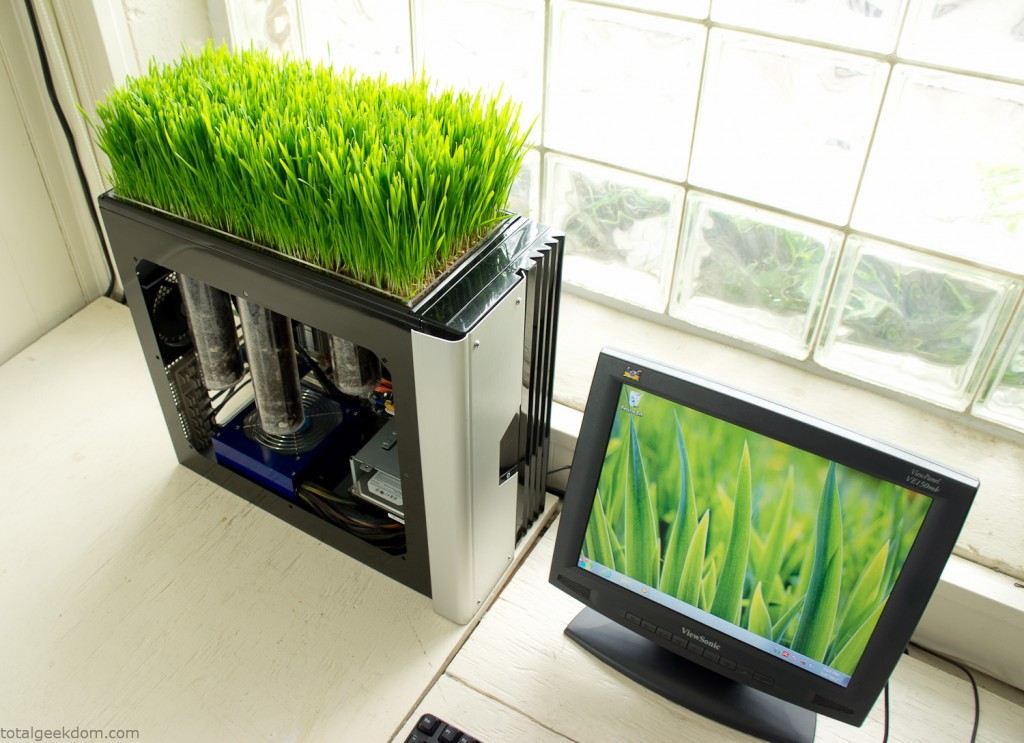









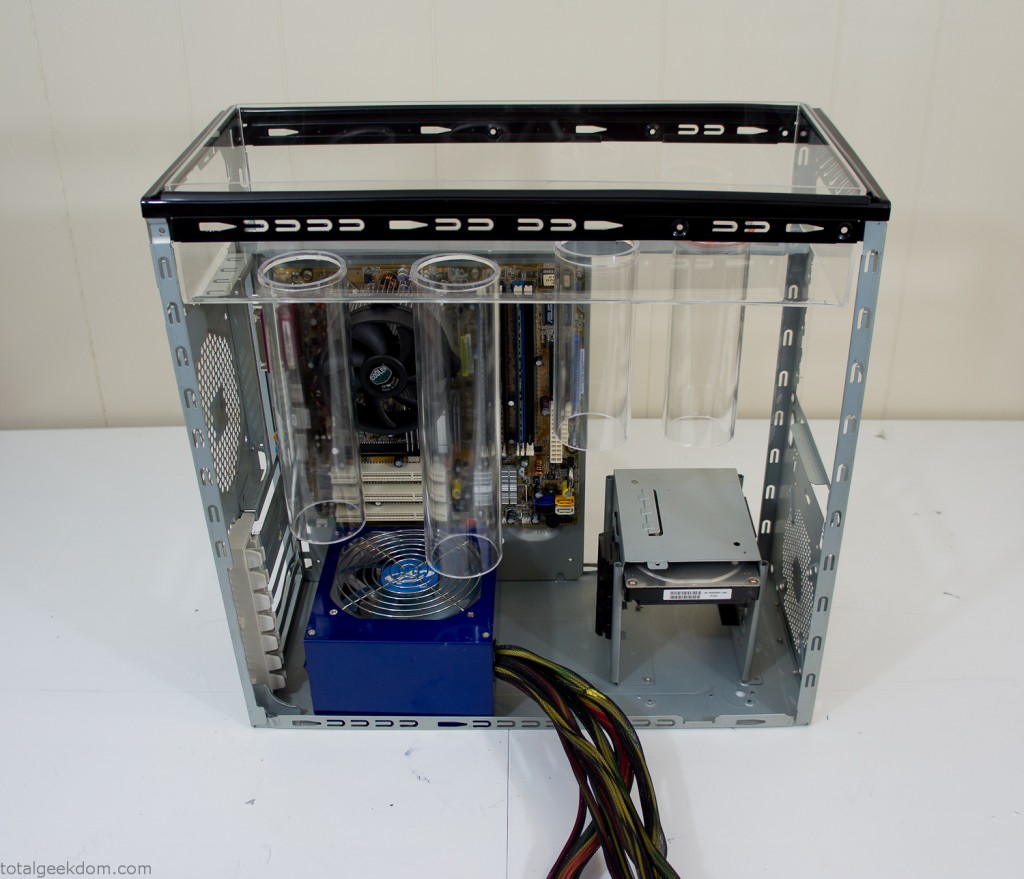



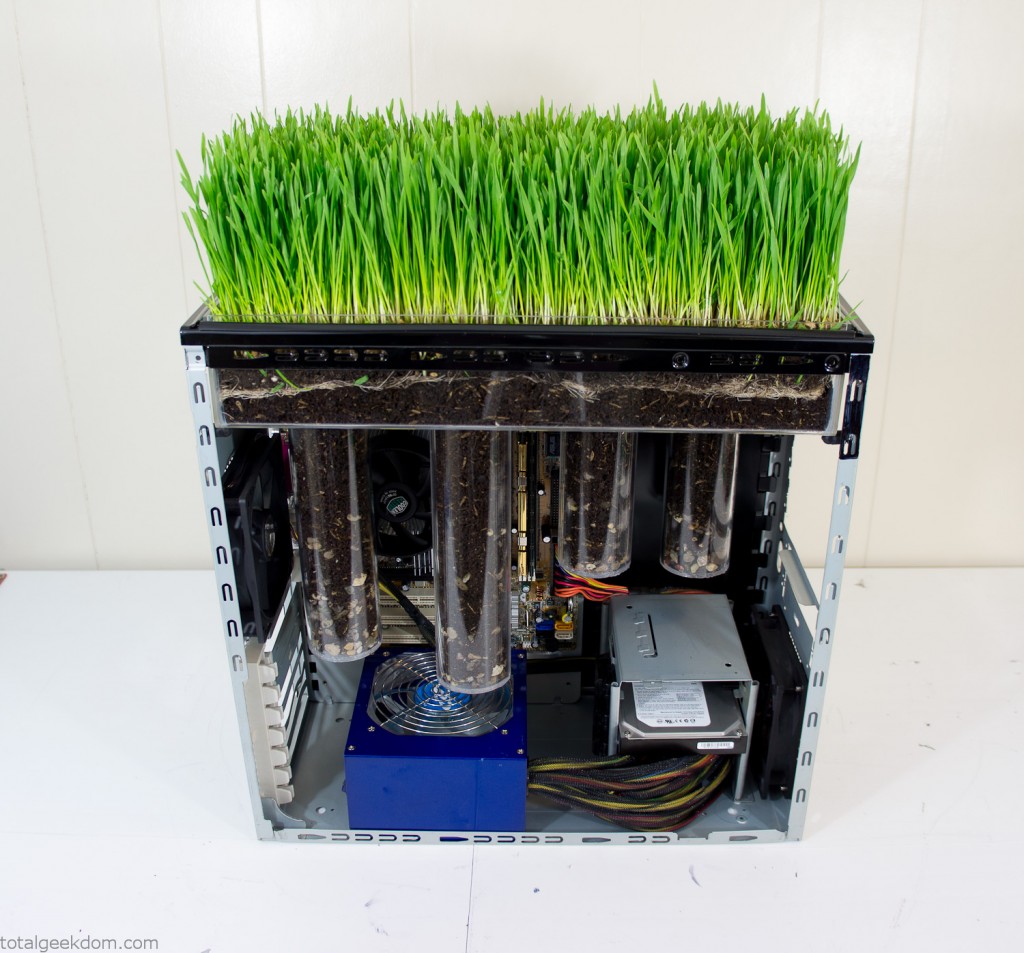
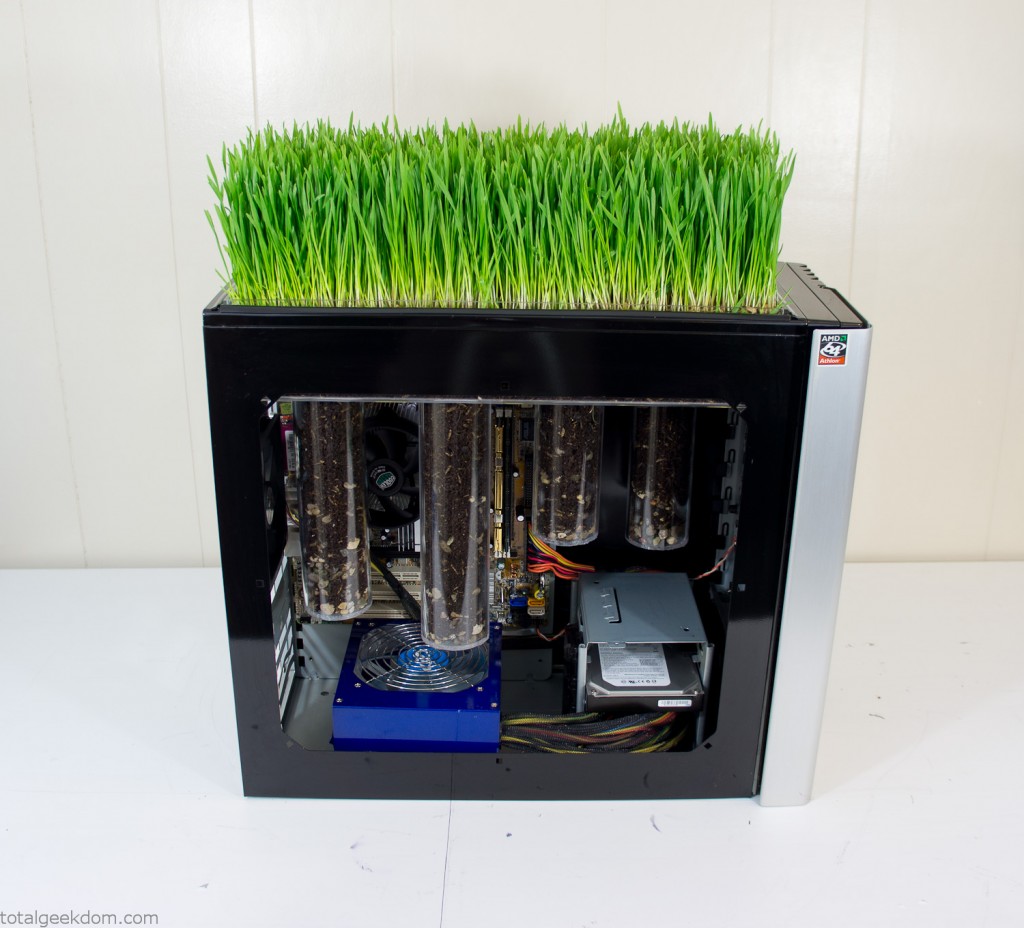

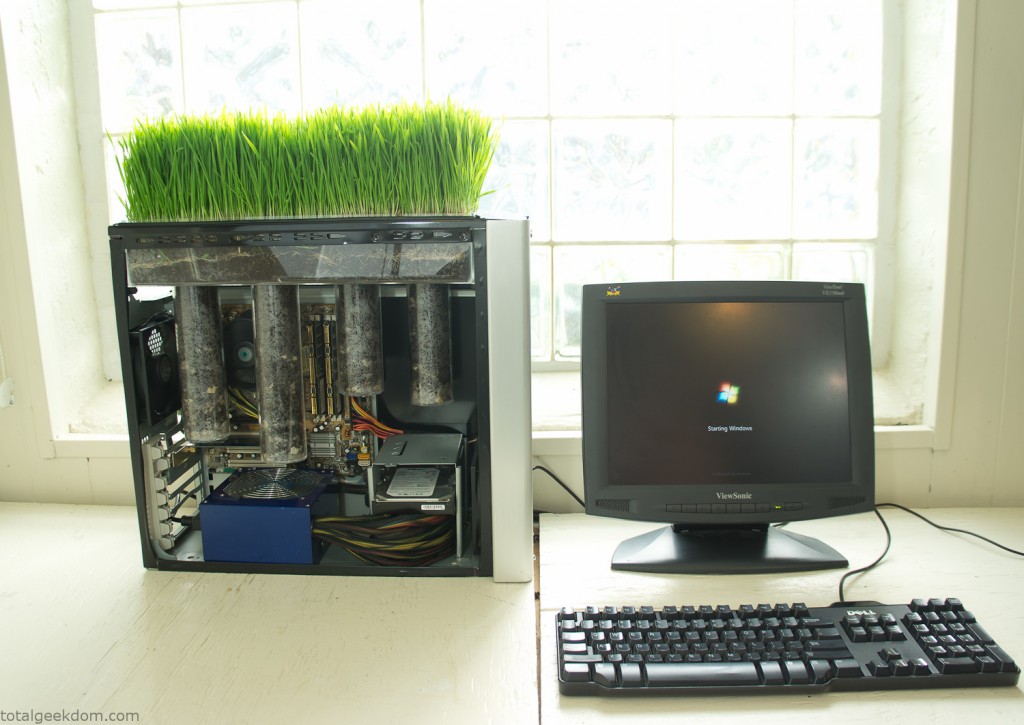



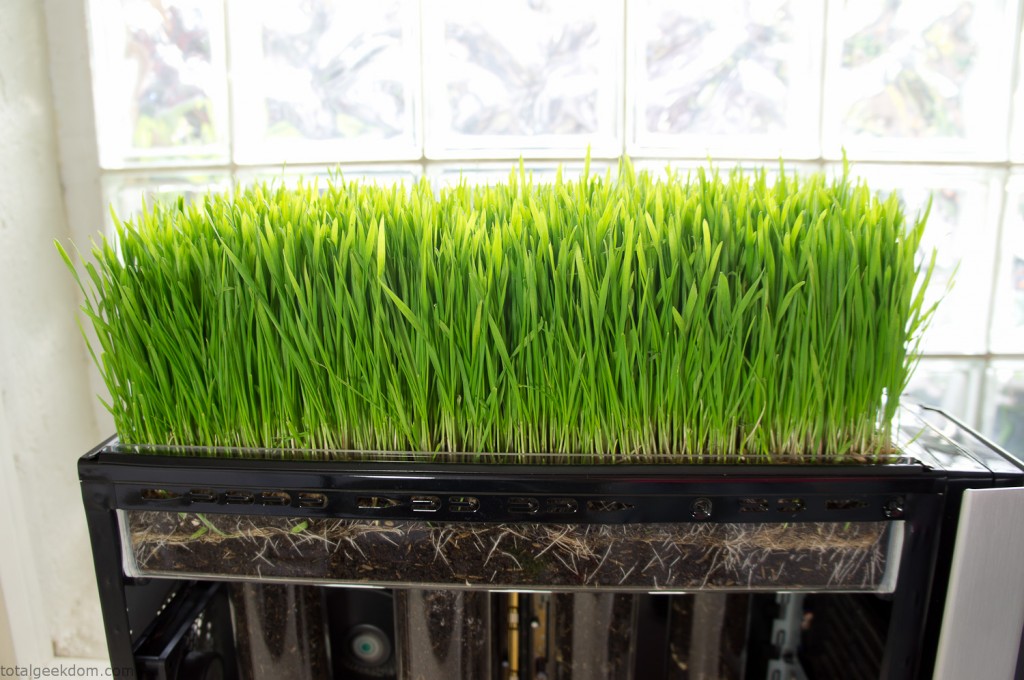

Comments 152
строительство загородных домов
Pingback: Este Techie convirtió su ordenador de trabajo en una maceta. Impresionante. | Qcosas
Pingback: Computerul transformat in gradina botanica. – WEB-DESIGNDORU PROIECTARE CREARE SI REALIZARE WEB SITE-URI PERSONALIZATE
Pingback: cheap Mu Legend Zen
Pingback: nike air max dámské
Pingback: cheap FFXIV Gil
Pingback: The Dark Side of the Digital Age: E-Waste – Welcome to healthTV.lk
Pingback: Plants in Unlikely Places
Pingback: Grow Grass on your Bio Computer | The Imminent City
Pingback: This Nerd Transformed His Working PC Into A Grower And It's Great
Pingback: E-waste problem and some creative solutions. » H.I.P.E. (FLL Team)
Pingback: Convirtió su ordenador de trabajo en una maceta. Impresionante.
Pingback: Literally “Go Green” with this Eco-Inspired Case Mod - Arduino collector blog
Pingback: Bio Computadora. Como hacer crecer trigo con tu Ordenador / EcoInventos.com
Pingback: The Dark Side of the Digital Age: E-Waste - Daily News Geek
Pingback: The Dark Side of the Digital Age: E-Waste | AGReGate.info
Pingback: Today in Technology April 27, 2015 | Tech Fann.com
Pingback: The Dark Side of the Digital Age: E-Waste - LA Sun Post
Pingback: The Dark Side of the Digital Age: E-Waste - Denver Sun Post
Pingback: The Dark Side of the Digital Age: E-Waste | Georgia World News
Pingback: The Dark Side of the Digital Age: E-Waste | Omaha Sun Times
Pingback: The Dark Side of the Digital Age: E-Waste - Seattle Sun Post
Pingback: Lego Computer | Total Geekdom
Pingback: Literally “Go Green” with this Eco-Inspired Case Mod | iDelaney
Pingback: This Techie Turned His Working Computer Into A Planter And It’s Awesome | Traffic Nova
Pingback: 技术人员用他工作的主机箱种植小麦 | 嗡在
Pingback: Literally “Go Green” with this Eco-Inspired Case Mod | Arduino collector blog
How is the power supply attached to the case?
Pingback: Upcycle Old Tech With Computer Mods | Blackle Mag
Pingback: Literally “Go Green” with this Eco-Inspired Case Mod | Linux-Support.com
Pingback: Un internaute fabrique un "Jardinateur" ! - Micro Plus
Pingback: The 404 1,245: Where we print with fire (podcast) | Product reviews and prices, software downloads, and tech news - CNET PRO
Pingback: The 404 1,245: Where we print with fire (podcast) | FS Dash Blog
Pingback: Techno Vision – The 404 1,245: Where we print with fire (podcast)
Pingback: Coffee-powered cannabis cars and bambara breakfasts on Plants Day | marketspace
Pingback: Plantacja na komputerze | Mieszkaniowe inspiracje
Pingback: | marketspace
nice man, now if only i had some money LOL
i got to say, you marvelous. I am running a computer recycling project for a charity in Australia. Your project inspired me and I am looking into it now see if i could find an easy way or a quick way to do your project and I’d really like to introduce it to community. I’d also like to put your store into our project and i might use your photo and mention your name, is that OK with you? Thanks.
Thanks! Very cool to hear about your recycling project.
Feel free to use my name and photos. 🙂
awesome.. you gave us something to think about http://pinnazz.wordpress.com
Thanks!
One word—-GENIUS! Only, creative mind can make something out of nothing.—<3
Thank you! Appreciate it! 🙂
http://www.youtube.com/watch?v=Dqusx15cUZw
Thanks for the info
Pingback: A green way to retire your old computer... (2010) - Sustainable living, ecology, conservation, local agriculture - City-Data Forum
great!
Thanks!
Hey! I did something similar 3 years ago at art school but I was looking into energy conversion/transition between organic matter to digital or electronic matter. This seems pretty cool though
**thenotsobusylife.tumblr.com
Thanks. Sounds like a cool project.
Pingback: Why can’t computers just solve everything? « patthegod
Pingback: Elektroschrott-Bikini und Bio-Computer | Bio Weizengras
This is a very interesting project! My dissertation is on the use of low temperature waste heat in industry, so I enjoyed your article a lot.
I have one question, does the rate of the wheat grass growth actually increase, compared to being grown at ambient temperature?
Thanks! Glad you enjoyed!
Yes, the ambient temperature in my basement (depending on the season) is sometimes below normal room temperature by a decent amount, so the growth of the test Wheat grass was slower at these slightly cooler temps. Once I added the heat from the computer and started increasing the temperature the rate of growth of the Wheat grass increased.
Pingback: dMASS Insights: Smaller, simpler solutions for resource savings — dMASS
Pingback: Bio computer – green PC | StiGGy's Blog
Pingback: Un Computer che sa far crescere l'erba.
Pingback: Case inteligente, AV news, gadget-uri » Blog Archive » Bio-calculatorul construit acasa
Pingback: Blog Campus Party Brasil
Pingback: Un ordinateur qui fait pousser de l’herbe | design-recyclers
Pingback: Caldura degajata de computer folosita pentru cresterea plantelor | La taifas despre oameni, locuri, intamplari